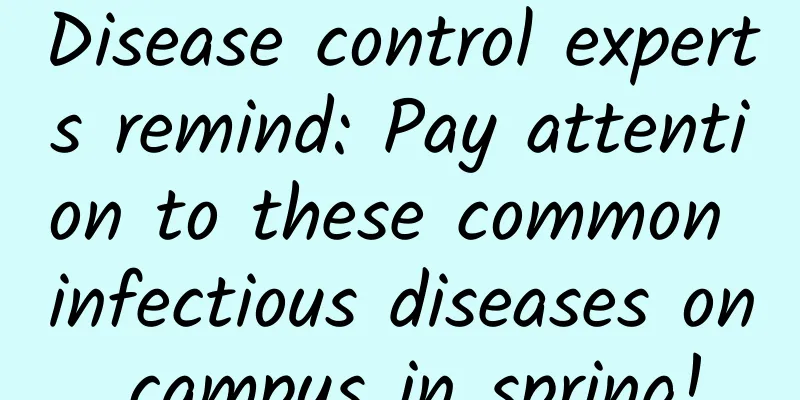Disease control experts remind: Pay attention to these common infectious diseases on campus in spring!

|
Recently, children have bid farewell to their winter vacation and returned to school one after another, starting a "hot and sizzling" new semester. Health experts from the Shaanxi Provincial Center for Disease Control and Prevention remind that it is early spring, and the temperature fluctuates. At this time, the human body's immunity is relatively low. If viruses and bacteria take advantage of the situation, it is easy to cause various infectious diseases. Since campuses are crowded places, preventing common campus infectious diseases in spring requires cooperation among families, schools, and students. Common infectious diseases in spring can be divided into three categories according to transmission routes and symptoms: respiratory infectious diseases, such as influenza and new coronavirus infection; digestive tract infectious diseases, such as norovirus infectious diarrhea; and rash infectious diseases, such as hand, foot and mouth disease and chickenpox. Respiratory infectious diseases should be prevented in daily life At present, we are in the peak season of respiratory infectious diseases in winter and spring, and influenza is still the main respiratory infectious disease. Influenza is mostly caused by influenza A or B virus, and symptoms include sudden high fever (up to 39℃-40℃), accompanied by chills, chills, headache, body aches, etc. Experts from the Virus Institute of Shaanxi Provincial Center for Disease Control and Prevention remind that influenza is mainly transmitted through air and droplets and is highly contagious. After school starts, there will be more gatherings of students, and attention should be paid to key prevention measures. Daily protective measures include maintaining good respiratory hygiene habits, opening windows for ventilation regularly, avoiding crowded places as much as possible, and wearing masks correctly when in close contact with others. When students have flu-like symptoms (body temperature ≥ 38°C, cough or sore throat), they should rest at home until their body temperature returns to normal and other flu-like symptoms disappear 48 hours later or according to the doctor's advice before returning to school. Flu vaccination is an effective means of preventing influenza. Children are susceptible to influenza, and it is recommended to complete the flu vaccination as soon as possible. Digestive tract infectious diseases: Beware of "diseases entering the body through the mouth" The peak season for norovirus is from October to March of the following year, and the school season is also the peak season for norovirus infection. Norovirus has the characteristics of short incubation period, low infection dose, strong environmental resistance, and diverse transmission routes. It is mainly transmitted through the "fecal-oral" route, and both adults and children are susceptible to infection. Schools and childcare institutions are densely populated, so we should focus on daily disinfection and food safety supervision. Regular disinfection includes increasing the frequency of cleaning and ventilation of public places, mainly including classrooms, dormitories, canteens, libraries, toilets, etc. Focus on cleaning and disinfecting key areas such as stair handrails, faucets, toilet buttons, and elevator buttons. If a case occurs, vomitus must be handled scientifically and in a standardized manner, and the surfaces of environmental objects contaminated by vomitus, feces, etc. must be disinfected. In addition, school canteens should strengthen food safety management to ensure that ingredients are fresh and cooked thoroughly, avoid food contamination, and reduce the possibility of norovirus transmission. Do a good job in monitoring the health status of kitchen workers and childcare workers in childcare institutions and schools, and prevent them from going to work while sick; staff need to wear masks and maintain good hand hygiene during food preparation and meal distribution. Do a good job in daily student health management, and ask patients with vomiting or diarrhea symptoms to seek medical treatment in a timely manner. If the number of cases increases abnormally, they should be reported immediately to the local disease control agency. Isolation measures should be implemented for rash-related infectious diseases In spring, the number of common rash-causing infectious diseases in children gradually increases, including chickenpox and hand, foot and mouth disease. These diseases have different pathogens and various transmission routes, but skin rashes will appear during the course of the disease. It is important to distinguish and carry out relevant isolation and treatment. Experts from the Virus Institute of the Provincial Center for Disease Control and Prevention remind that chickenpox is mainly transmitted through air droplets and direct contact, which is more common in preschool children, and the immunity is long-lasting after the disease. Symptoms are mostly low fever, headache, fatigue, loss of appetite, and the rash is distributed centripetally. Macules, papules, herpes and scabs can be seen in the same part. After being infected, the child must be isolated until the rash on the whole body is scabbed, and the time is generally not less than two weeks after the onset of the disease; during the rest period at home, avoid contact with other children; treatment is mainly symptomatic, the skin is kept clean, and scratching is avoided. Parents should pay attention to the child's condition. If the child continues to have a high fever after the rash, headache, irritability, and convulsions, he should be sent to the doctor for treatment in time. Hand, foot and mouth disease is a Class C infectious disease that is subject to statutory reporting management in my country, and is mostly caused by enterovirus. It is more common in children under 5 years old and can be transmitted through eating together, contact with patients' water cups, toys, towels and other items. Symptoms are mainly fever (about 38°C), herpes on the hands, feet and buttocks, and ulcers in the mouth. In a few cases, the disease progresses rapidly, and meningitis, encephalitis, pulmonary edema, etc. occur about 1-5 days after onset. The younger the child, the greater the chance of severe hand, foot and mouth disease. To effectively prevent the occurrence of severe hand, foot and mouth disease, it is important to vaccinate against enterovirus 71 (EV-71) in time. This vaccine only has a preventive effect on enterovirus 71, with a protection efficiency of about 90%. Children over 6 months old and under 5 years old can be vaccinated with this vaccine, a total of 2 injections, at least 1 month apart, and it is recommended to complete the vaccination before 1 year old. After being infected, the child should be isolated at home until all symptoms disappear for 7 days. During this period, pay attention to rest, oral care and skin cleaning; parents should pay special attention to the progress of their children's condition and seek medical treatment in time if necessary. |
>>: Lunar back sampling, intelligent rockets... 2024 China Space "Spoiler" | Expo Daily
Recommend
Seed User Operation Methodology
The author shares his thoughts and experiences on...
Apple iOS 9 may integrate smart home applications
Beijing time, May 21 morning news, American techn...
How to systematically design online and offline brand activities?
Different from daily operational activities, offl...
The long-awaited "WeChat Customer Service" is here. The official website is now online
Many people complain that WeChat has no customer ...
Toothache is really a disease! Not only does it hurt, it can also cause these physical diseases——
Review expert: Wang Xuejiang, professor at Capita...
CNBC: Ford Motor Company's new car sales in the United States fell 17% in the first quarter of 2022, with a year-on-year decline of 26% in March
According to CNBC, Ford Motor Company's new c...
The latest news on Beijing’s unblocking time in 2022: Has it been fully unblocked? Attached is the latest official notice
Since May, the number of newly confirmed cases re...
The "Pig Trotter Noodles" that ranked first on the "Crazy" food list actually "doesn't exist"?
The popularity of "Kuaishou" has made a...
What are the flight orbits of the Fengyun satellites that appear in the weather forecast every day?
We are used to checking the weather before going ...
Yuppie Emotions·Laosan Love Study "Dating Course"
Quick love, emotional manipulation, freezing and ...
How much does it cost to attract investment in Yichun Mobile Phone Accessories Mini Program?
The advantages of WeChat mini program investment ...
Lei Jun vs. Zhou Hongyi: A 20-year-long "battle between heaven and earth"
Destined to be unfriendly "The predecessors ...
What can we find from the pig's nose digging the ground? They invented the predecessor of the mask
Under the epidemic, masks have become a necessity...
Don’t eat! Don’t eat! Don’t eat! Official important reminder
Important reminder! Delicious looking wild mushro...
Tips and strategies for becoming a “super user”!
The free feast on the Internet is becoming a thin...









